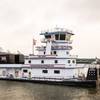Marine diesel engines have long been subject to classification society rules. However, from the start of next year, a whole new - and quite separate control regime will begin to take effect with major implications for both new and existing engines.
Annex VI of MARPOL 73/78, dealing with a wide range of air pollution control matters (including ozone depleting substances, acid deposition materials, volatile organic compounds, incineration and oil fuel quality), is still some way from reaching the required level of ratification to enter into force. Nevertheless, the time is fast approaching when some of the provisions of that Annex will start to take effect. This is particularly true in terms of the oxides of nitrogen (NOx) controls, Regulation 13. As shown in Figure 1, engines installed on ships constructed on or after January 1, 2000 will, following the entry into force of the Annex, need to meet the relevant certification requirements contained in the Annex. So too will those engines which, on or after January 1, 2000, have been subjected to a 'major conversion', as defined within the regulations, irrespective of the date of construction of the ship on which they are installed.
While the date of January 1, 2000 is written into Regulation 13, compliance between then and the entry into force date, which may be a few years off, should be seen as voluntary early compliance. However, this should be seen as a very qualified voluntary. Following the entry into force of the Annex, a year after achieving the required level of ratification, an International Air Pollution Prevention (IAPP) Certificate, of which the NOx controls are but one aspect, will become essential for a ship to trade on an international basis. As shown in Figure 1 for existing ships at that time there will be a maximum period of up to three years in which to obtain this certificate. Where those engines to which Regulation 13 applies are not already voluntarily compliant, shipowners will face a monumental, if not near impossible in some cases, task at that time in obtaining that essential certification.
The first stage of achieving this compliance with the NOx control requirements is through either pre-certification or testing onboard, after installation in a few instances or more usually on completion of any major conversion, in accordance with the procedures as set out in the IMO NOx Technical Code. This Code is a mandatory document that underpins the Regulation 13 requirements. Consequently, despite the voluntary nature of this compliance over the next few years, the pressure will be on engine builders and those responsible for undertaking major engine conversions to provide the necessary approved documentation at the time of installation or following conversion. By so doing this will reduce the NOx aspects of the IAPP Initial Survey to a relatively simple matter of verification rather than turning the ship into a seagoing emissions measurement laboratory.
New Engines
All engine builders who supply engines that will fall within the scope of the Annex VI requirements for installation on ships built on or after January 1, 2000 will therefore generally be expected to supply engines that are either pre-certified or, in those few cases where engines cannot be accommodated on test beds, tested to the required extent onboard following installation. When the Annex enters into force, pre-certification will result in the issue of an Engine International Air Pollution Prevention (EIAPP) Certificate; however, in the interim period it will be a Statement of Compliance with the NOx Technical Code which will be issued instead.
The actual engine certification process depends on the principles that NOx emissions do not increase over the service life of an engine and that, under standardized conditions, do not differ between engines of the same design, adjustment and usage. Consequently, the basis of the whole NOx certification program is to measure once but rigorously, as per the NOx Technical Code, for the Parent Engine and thereafter to ensure by means of the conformity of production that all subsequent engines, to be covered by that test, will have NOx emission rates no higher than that of the Parent Engine.
The approval process for a Parent Engine divides into a number of stages:
? Categorization into either Engine Family or Engine Group depending on the potential range of adjustment and the possibility of modifications
? Selection of the Parent Engine - The Parent Engine is to have the highest NOx emission rate of all those engines within the Engine Family or Engine Group which are to be represented by that Parent Engine.
Adjustment and fit of the Parent Engine as tested. Again these are to such as to give the highest NOx emission rate for the selected Parent Engine.
Parent Engine test in accordance with the NOx Technical Code.
Preparation of the Technical File - this is to give the engine's rated performance, any designation and restrictions and identify the components, settings, operating values and adjustment ranges of those items which can affect the NOx emissions. The specification of spare parts is also to be included. In the case of Engine Group members, the Onboard NOx Verification procedures must also be given.
Since these aspects tend to be very specific to the engines under consideration, it is for the engine builders to prepare their proposals in respect of each of these five stages and to submit these for approval to the relevant administration or delegated organization. In order to support the proposed Parent Engine selection, adjustment and fit, it may be necessary for the engine builder to have undertaken a number of emission trials to determine the actual effects of the various factors that influence NOx formation during the combustion process with the Parent Engine test therefore being the final verification of performance. In addition, for series produced engines, the engine manufacturer would need to show that adequate arrangements will be in place to ensure effective control of the conformity of production.
Major Conversions
For those engines within the scope of the Annex VI requirements, a major conversion is defined in the NOx Technical Code as where the engine is replaced by a new engine built on or after January 1, 2000, where the maximum continuous rating of an engine is increased by more than 10 percent or where it is subject to a 'substantial modification.' The definition of substantial modification depends on when the ship was built. For those built on or after January 1, 2000 substantial modifications are those that could potentially cause the engine to exceed the NOx limits as set out Regulation 13 of Annex VI. For ships built prior to that date the engines would not normally have been subject to any emission control measures and hence may have NOx emission rates well above those permitted by Regulation 13. In the latter case the NOx Technical Code requires that the NOx emissions be quantified in accordance with the Simplified Measurement Method, as given in the Code, prior to and on completion of those modifications. If the NOx emission value increases by more than the set allowance, 10 percent or 15 percent depending on test conditions, then that engine as modified thereafter falls within the scope of the Annex VI requirements and will therefore need to meet the relevant NOx limit as set out in Regulation 13, be provided with an approved Technical File and be subject to subsequent surveys.
Consequently, from January 1, 2000 shipowners contemplating modifications to those engine components or settings (i.e. combustion chamber geometry, oil fuel injection arrangements or charge air system) which could affect the NOx emission value will need to take particular care as to the effect of those modifications as to an engine's status as regards Annex VI. In the case of engines on ships built before January 1, 2000, it should be recognized that the possible need to perform two sets of emission measurements onboard and go through the attendant approvals process is one that should not be undertaken lightly.
Uniformity of Approach
The certification aspects resulting from these NOx controls will be the responsibility of the Flag State of the ship on which an engine is, or will be installed. But, as with other MARPOL work, the administrations may delegate that work to other organizations, which are able to act on their behalf. It is of great importance to both engine builders and shipowners to have a unified procedure for this certification on a worldwide basis. Not only will this reduce the difficulty in reaching common interpretations of aspects within the regulations but also simplifies matters where change of Flag is undertaken. Currently, the bulk of the work associated with the NOx controls is being undertaken by the classification societies, which, through IACS, have a ready means of achieving common agreement between themselves. This matter of agreement is crucial since if there were to be irreconcilable differences in approach between the various organizations issuing the certification then the smooth operation of the whole system would be impossible. Consequently, it may be seen that the widespread delegation of this NOx certification work to the classification societies would be an effective way of providing the essential uniformity of approach.
With all this work associated with the introduction of NOx emission controls, particularly since it addresses matters, which historically have not been of concern to the marine industry, it is to be expected that any number of questions will arise from and between Administrations, classification societies, engine builders, shipowners and others. The CIMAC Exhaust Emission Controls Working Group, as a cross industry forum involved in these matters consequently anticipates a busy and productive future.
Sponsored Content
Lower carbon intensity fuels to support your operations

Subscribe for
Maritime Reporter E-News
Maritime Reporter E-News is the maritime industry's largest circulation and most authoritative ENews Service, delivered to your Email five times per week










